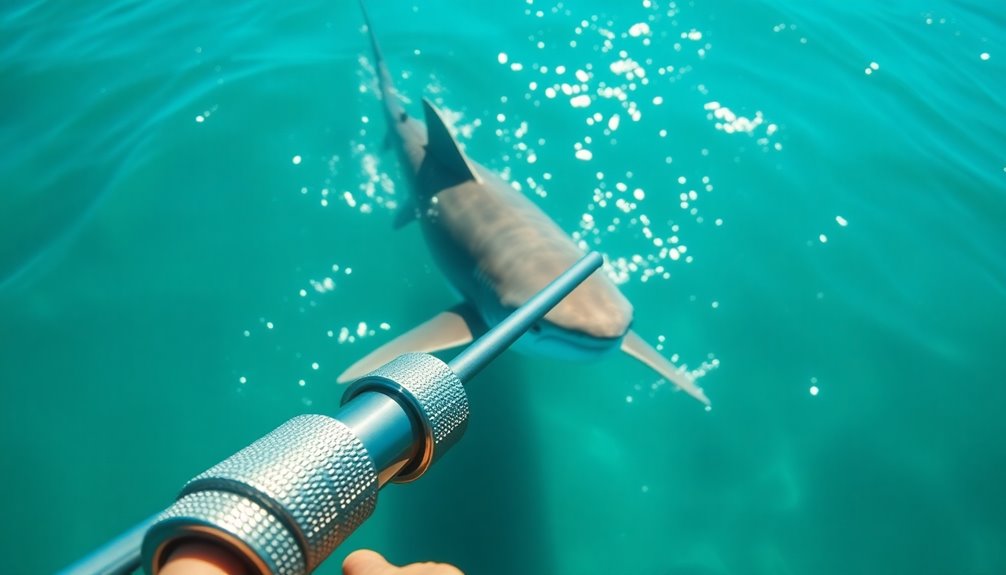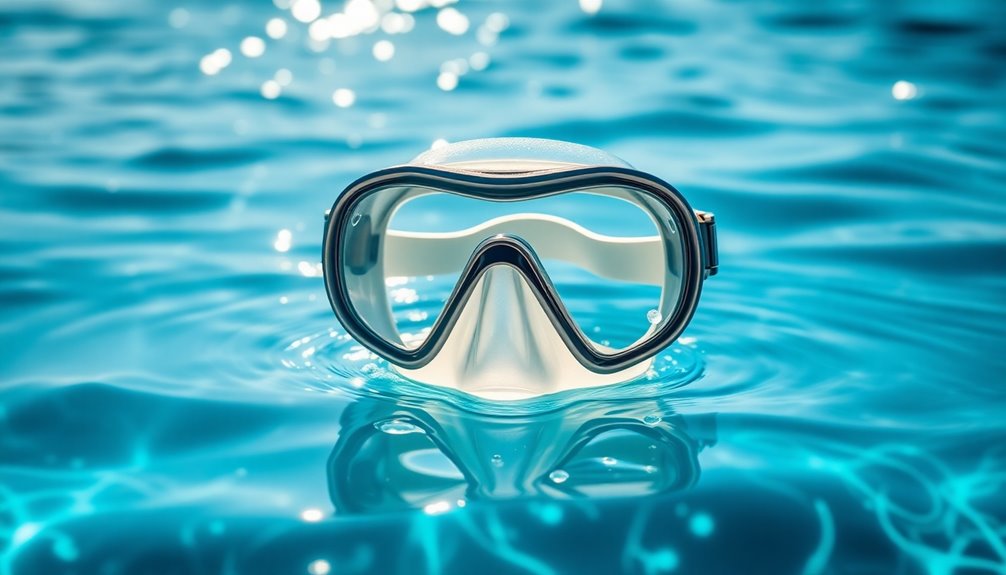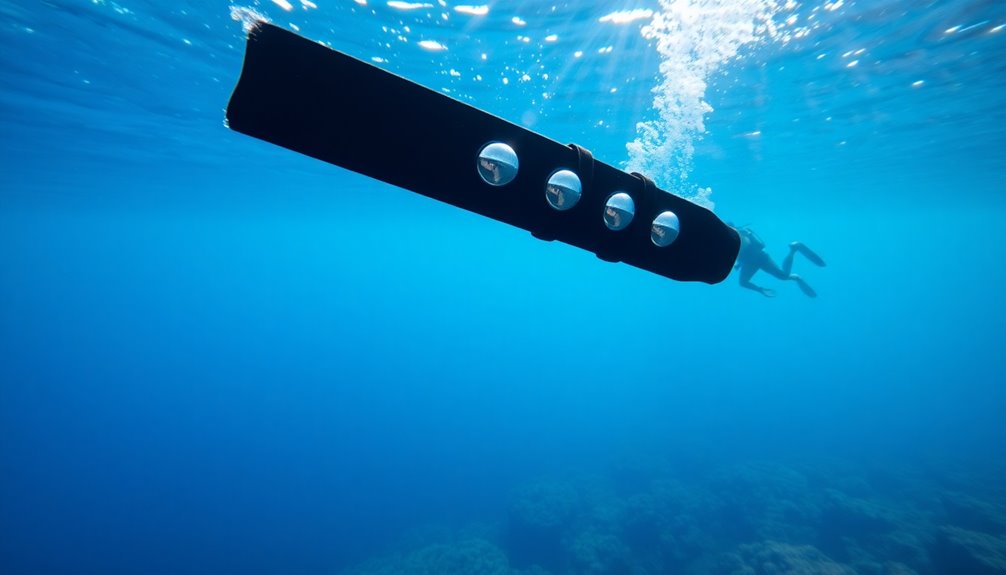When you gear up for lobster diving, you've got the tools to release the hunter within. Start with a quality wetsuit for thermal protection and sturdy fins for smooth movement. Don't forget your flashlight; lobsters are nocturnal, and it's vital for spotting them in low light. Reinforced gloves will keep your hands safe from sharp shells, and a quick-release lobster bag is important for storing your catch. Always check the local regulations and size limits before you dive. Exploring more about techniques and gear maintenance can enhance your experience and guarantee a bountiful catch!
Key Takeaways
- A quality wetsuit (5-7mm) is essential for thermal protection in colder waters during lobster dives.
- Solid plastic fins enhance comfort and maneuverability, allowing for efficient movement underwater.
- Reinforced gloves protect your hands from pinches and rough surfaces while handling lobsters.
- A quick-release lobster bag is crucial for safely storing your catches after capture.
- Always carry a measuring tool to ensure compliance with local size regulations when harvesting lobsters.
Overview of Lobster Diving Techniques
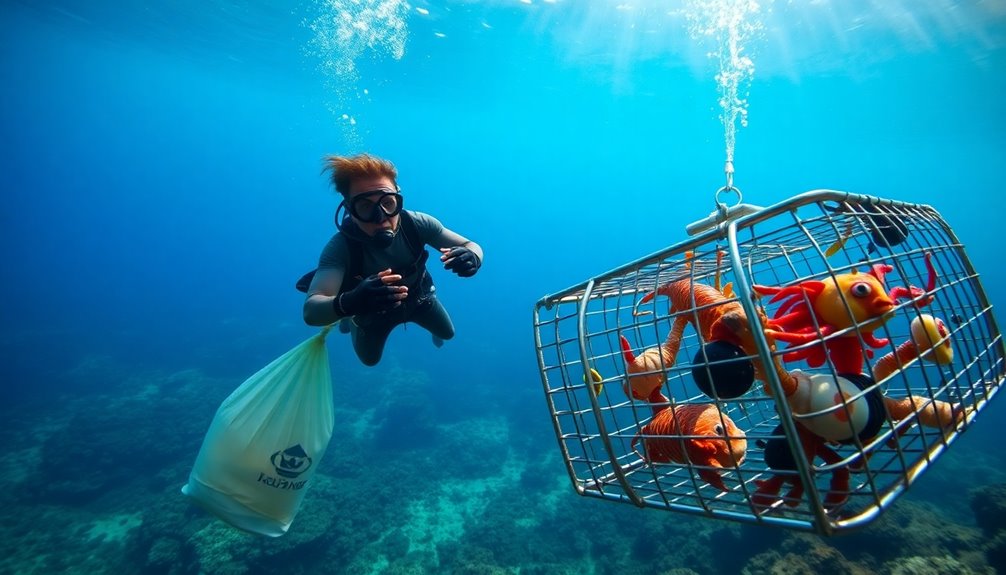
When it comes to lobster diving techniques, understanding the best practices can greatly enhance your experience and success. A lot of people prefer night dives since lobsters are nocturnal and far more active after dark.
While you can dive during the day, visibility issues can make it more challenging. Free diving is a popular method, and using a flashlight is crucial for locating lobsters. The right angle can help create silhouettes that make catching them easier—just remember to approach quietly to avoid startling your catch.
Always dive with a buddy for safety, keeping each other informed about local conditions like currents and visibility. This teamwork not only enhances your diving experience but also guarantees you stay safe.
If you're diving in murky water, having a spotter can be particularly beneficial. They can help you locate lobsters without disturbing their environment, increasing your chances of success.
Ultimately, mastering these techniques won't only boost your catch rates but also guarantee you enjoy every moment underwater. With the right approach, you'll be well on your way to becoming a skilled lobster diver.
Essential Gear for Lobster Diving
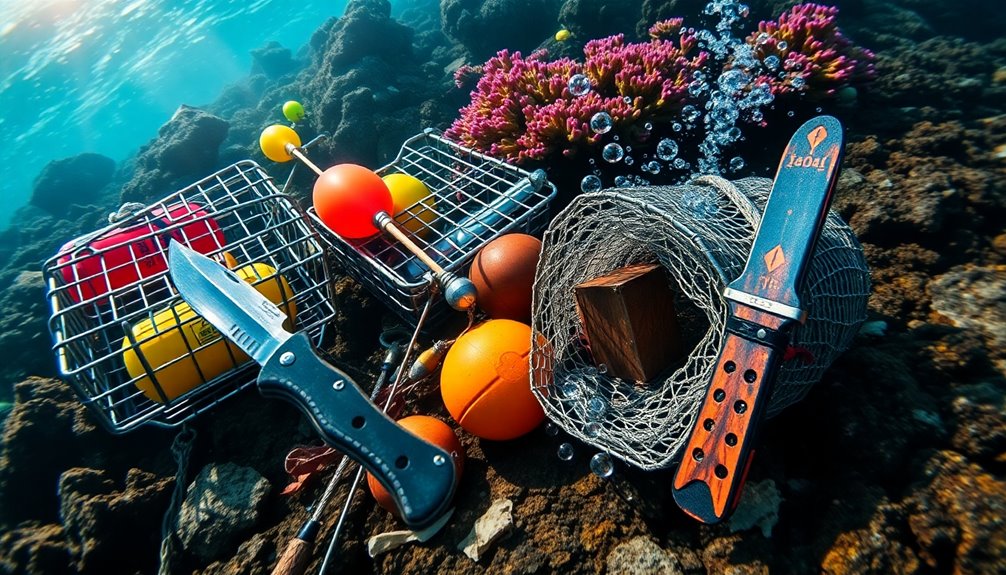
To enjoy a successful lobster diving adventure, having the right gear is fundamental. Start with a quality wetsuit, ideally 5-7mm thick, to keep you warm in cold waters and guarantee durability. You'll also want solid plastic fins for comfort and better maneuverability, which are critical for extended dives.
Don't forget a reinforced pair of gloves; these protect your hands from lobster pinches and rough underwater surfaces. A quick-release lobster bag with clips is also essential for safely storing your catches while you dive. Finally, a measuring tool helps guarantee your lobsters meet legal size requirements, promoting sustainable diving practices.
Here's a quick overview of fundamental gear:
| Gear Item | Purpose | Recommended Features |
|---|---|---|
| Wetsuit | Thermal protection | 5-7mm thickness |
| Gloves | Hand protection | Reinforced for durability |
| Measuring Tool | Size verification | Accurate and easy to use |
Equipping yourself with these essentials will make your lobster diving experience both enjoyable and responsible. Dive smart, and happy hunting!
Safety Regulations and Legal Considerations
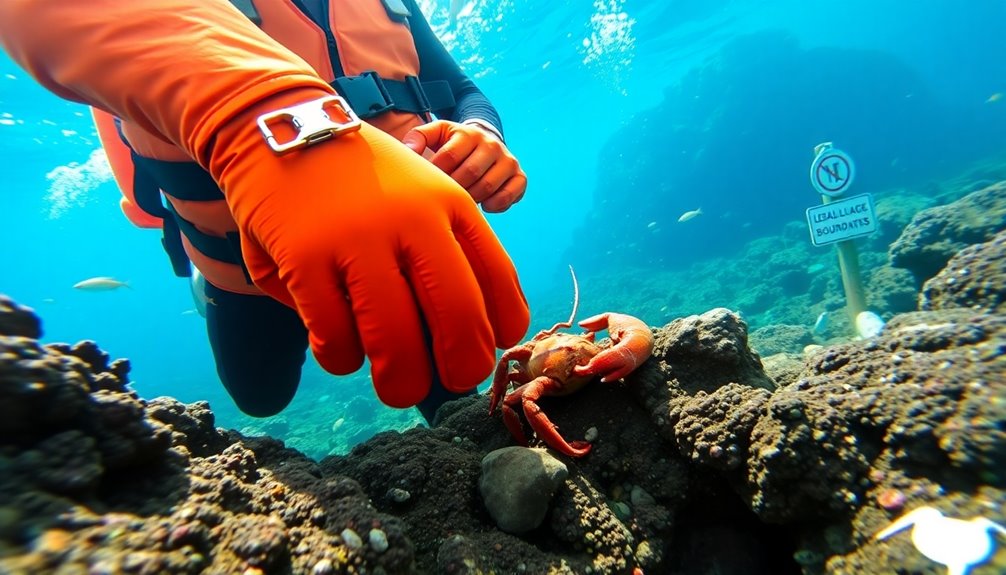
Before heading out for a day of lobster diving, it's important to understand the safety regulations and legal considerations that govern the activity. Start by obtaining a lobster card to guarantee compliance with local regulations on harvesting practices.
Familiarize yourself with local size and catch limits, as penalties can arise from keeping lobsters that don't meet the legal size requirements. Staying updated on seasonal restrictions is vital, too, since these can differ by region and dictate when lobstering is allowed.
Always keep your permits accessible during your diving trips to avoid legal complications. If authorities check your catch, having your permits ready will help demonstrate your adherence to regulatory guidelines.
It's also smart to inform someone about your dive location and expected return time to enhance safety in case of emergencies.
Post-Dive Gear Maintenance
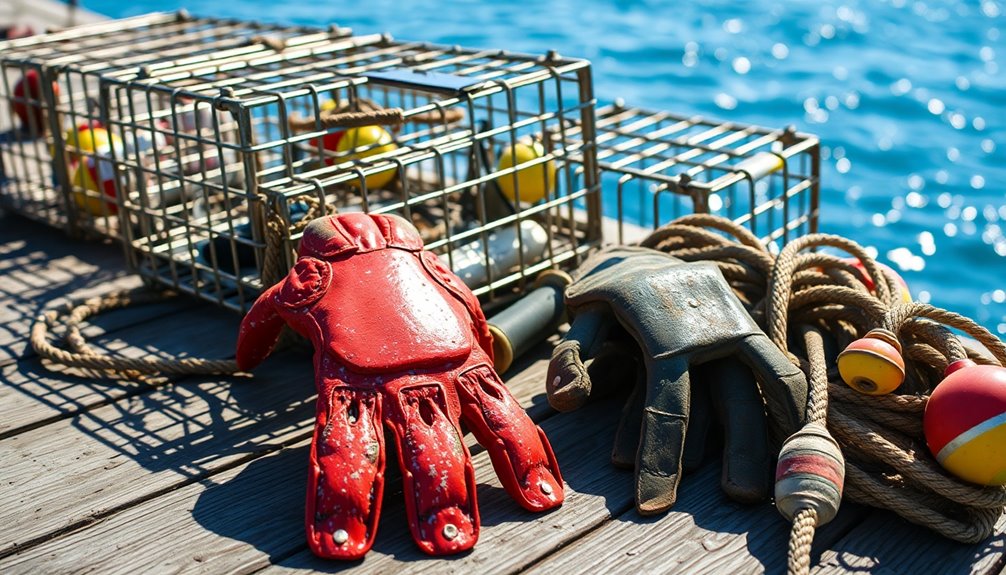
Post-dive gear maintenance is essential for guaranteeing your diving equipment remains in top condition and ready for your next adventure.
After each dive, make it a habit to clean all your gear thoroughly with fresh water. This simple step removes salt and debris, prolonging the life and functionality of your equipment.
Next, inspect all your diving gear for any signs of wear or damage. Look closely at straps, seals, and other critical components. If you spot any issues, replace those parts immediately to maintain safety and performance. Your gear's integrity is key to having a successful dive.
Once you've cleaned and inspected everything, it's time to store your gear properly. Find a dry, well-ventilated area to prevent mold and deterioration. Organize your equipment in a dedicated dive bag for easy access on your next outing.
Don't forget to regularly check and recharge batteries for your dive flashlights and other electronic devices. Being prepared guarantees functionality for future trips.
Finally, reviewing footage from your dives can help assess gear performance and technique, allowing you to identify areas for improvement when you dive again.
Community Engagement and Sharing Tips
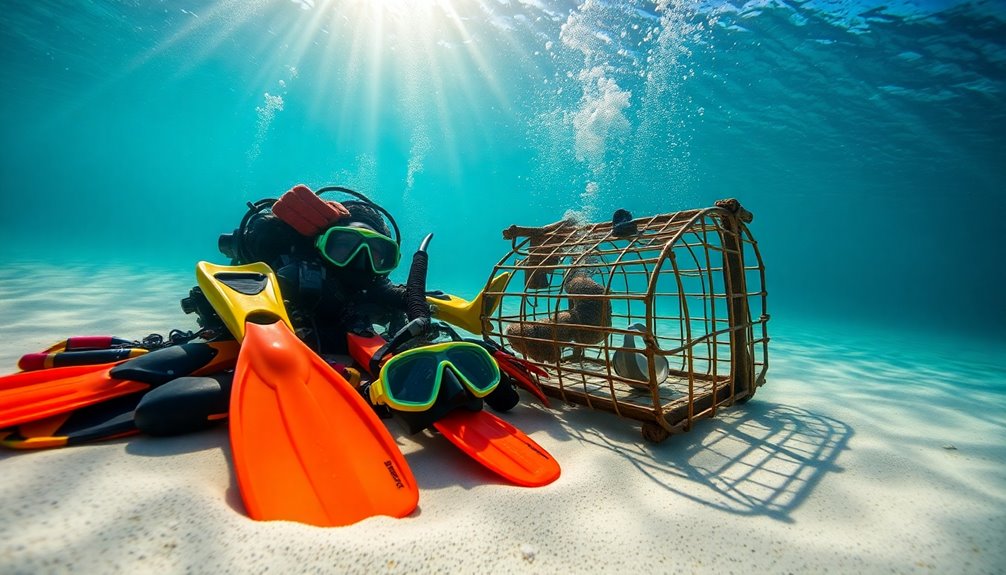
Connecting with fellow divers can greatly enhance your lobster diving experience and knowledge. By sharing your personal diving experiences and techniques, you'll foster a supportive community that thrives on learning from each other. Make sure to utilize social media platforms and local diving forums to post tips and ask for advice on gear, locations, and strategies. A lot of guys have valuable insights that can help you improve.
Participating in community dive events is another great way to build camaraderie among lobster hunters. Exchanging knowledge and best practices in person is invaluable. Plus, using video footage from your dives allows you to analyze techniques and share successes, which can really lead to improvement. Additionally, being aware of user consent management can ensure that your community interactions remain respectful of everyone's privacy.
Here's a quick reference to help you get started:
| Tip | Benefit |
|---|---|
| Share personal experiences | Builds a supportive community |
| Participate in events | Fosters camaraderie |
| Use video footage | Identifies areas for improvement |
Encourage others to give feedback on your tips, promoting interaction and enhancing collective knowledge in lobster diving. A community that shares is a community that grows!
Seasonal Insights for Lobstering
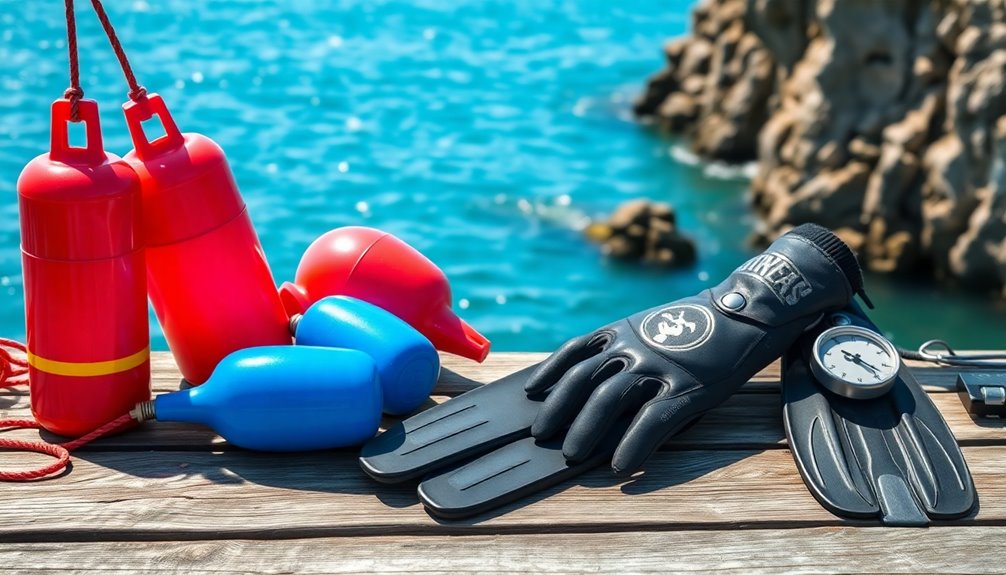
Understanding seasonal insights is crucial for successful lobster diving. By being aware of the changing temperatures and the behavior of lobsters throughout the year, you can greatly improve your catch. When temperatures drop below 50°F, males dive deeper, while pregnant female lobsters burrow into the substrate. This seasonal temperature awareness is critical to your strategy.
During the colder months, lobsters are more abundant and slower, providing you with a unique opportunity to catch them. However, keep in mind the importance of ethical lobstering practices.
Here are a few things to keep in mind:
- Handle pregnant female lobsters gently to protect the future population.
- Familiarize yourself with local regulations and size limits.
- Plan your dives around seasonal patterns to enhance your success.
- Respect the underwater ecosystem to guarantee sustainability.
Frequently Asked Questions
What Gear Do You Need for Lobster Diving?
To dive for lobsters, you'll need essential gear.
Start with a 5-7mm wetsuit to keep warm in cold waters. Solid plastic fins help you move efficiently over rocky terrain. Additionally, a well-fitted wetsuit can significantly enhance your comfort and mobility while swimming. Should you encounter any issues with your gear, knowing how to fix your wetsuit can save you from a potentially chilly experience. Regular maintenance, such as inspecting for rips or seams, ensures that you’re always prepared for your aquatic adventures.
Don't forget reinforced gloves to protect your hands from pinches. A reliable flashlight is vital for illuminating dark areas and attracting lobsters.
Finally, bring a quick-release lobster bag with clips for safely storing your catch and easy access when you need it. Additionally, having a quick-release lobster bag will help you keep your lobsters secure while allowing you to manage your catch efficiently. Don’t forget to incorporate lobster net and tickle stick tips for a more effective harvesting experience; these tools can significantly increase your chances of success while minimizing stress on the lobsters. With the right equipment, your lobstering adventure can become both enjoyable and rewarding.
Why Do Lobsters Walk Claw in Claw?
Lobsters walk claw in claw for several reasons. They display dominance and assert territoriality, especially during mating rituals. This behavior helps establish their social hierarchy.
When you observe them, you'll notice the larger crusher claw plays a key role in defense and competition.
Walking together also serves as a strategy against predators, as a united front appears more intimidating. By moving in sync, they communicate effectively, signaling aggression or submission to each other.
Can a Lobster Survive With One Claw?
Yes, a lobster can survive with one claw. They've an impressive ability to regenerate lost limbs over time, although it can take several molts and a lot of energy.
However, you'll notice that losing a claw makes them more vulnerable, affecting their feeding and defensive strategies. They may become more cautious and change their foraging habits to adapt.
It's essential to return these lobsters to their habitat to maintain ecological balance.
How Much Do Lobster Divers Make?
Lobster divers typically make between $20,000 to $60,000 annually, depending on where you dive, your experience, and how many lobsters you catch.
In peak season, if you're in a lucrative area like Maine, you could earn over $1,000 in just one day.
However, keep in mind that market prices for lobsters fluctuate, impacting your earnings.
Many divers also work with commercial fishing companies, which can provide additional income opportunities.
Conclusion
Now that you're equipped with the techniques and gear for lobster diving, why not take the plunge and experience the thrill for yourself? Remember to prioritize safety and keep your gear in top shape for every dive. Engaging with the community can also enhance your skills and knowledge. So, gather your buddies, plan your next adventure, and let the ocean reveal its treasures to you—one claw at a time! Happy diving!


